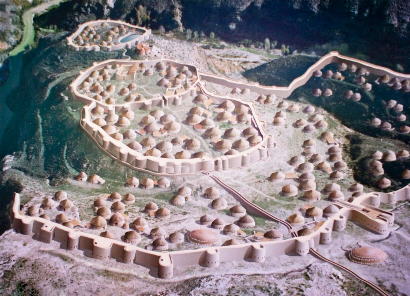++++++++++++++++++++++++++++++++++++
IBERIA CENTERED
++++++++++++++++++++++++++++++++++++

fortified Settlement of Los Millares
| LORDS OF THE EARTH 38 - THE DAWN OF CIVILIZATION | |
| Newsfax Turn: #9 ( 2090 - 2086 BC ) | |
| May 1, 2016 |
|
NILE VALLEY WAR
GM Comments: Four nations were still involved (Herakleopolis vs Minoans, Old Kingdom & Nubia). 2090 BC Skilled general Scota of the Old Kingdom defends its border with Middle Egypt with nearly 2,500 swordsmen. Soon reinforcing the Old Kingdom's army is Kyrsi of the Minoans with another two thousand archers, swordsmen and skirmishers. In Upper Egypt, Nubian King Shasesi watches the border with Middle Egypt with nearly 3,500 archers, swordsmen and skirmishers. In midsummer he is reinforced by lieutenant Rufa'a with over a thousand heavy infantry (sweating profusely in their armor) and yet more archers. Meanwhile in Middle Egypt King Sekhimib waited with over 5,500 infantry amid numerous stone forts, ready for an attack from either north or south. The year passed peacefully, to the disappointment of embalmers and gravediggers. 2089 BC All four armies continue to stand ready expecting the other side to attack. By early summer Kyrsi of the Minoans has had enough of inaction and leads his men east across the Nile into Mansura, then south towards the Ghebel Gharib desert. 2088 BC In early spring while the Old Kingdom, Herakleopolitan and Nubian armies remain vigilant, two thousand Minoan warriors cross into Ghebel Gharib. Realizing the enemy is earning income by trading through the Red Sea port of Mersa Gawasis, Kyrsi resolves to cut that trade route. The desert nomads pay tribute to Herakleopolis and see no reason to fight to continue doing that. Nevertheless Kyrsi orders them all enslaved which does provoke a fight. Unlike the Minoans (who regard the region as Hell) the natives are at home in the desert and slightly outnumber the invaders. They are however lightly armed and unused to massed bowmen who inflict hundreds of casualties upon them from a distance in the course of numerous ambushes and skirmishes. It still takes Kyrsi until the end of the year to kill enough tribesmen (including their war chief) that their power is broken; it costs the Minoans nearly 400 dead. Wisely they avoided doing any harm to the Egyptian Priesthood's temple shrine. Now cut off from Herakleopolis by wasteland, the elders of Mersa Gawasis revoke their port's tributary status and declare it neutral and independent. 2087 BC No one attacks. The Minoans prod long columns of shuffling slaves back through Mansura and across the Nile to Memphis by the end of the year. King Sekhimib of Herakleopolis, in his late 50s and worn down by years of strain, dies when overcome by heat during the particularly hot summer. Second of the Minoan Council Tavrys (healed from his wound at Thapsos) arrives late summer with a dozen galleys including four pentaconters to sweep the Nile for any ships trading at Herakleopolis. Alas for the would-be-pirates most Herakleopolitan galleys were sheltering in port. Three others were intercepted but run ashore and set afire by their crews before they could be boarded; their cargos of cedar at least smelled pleasing as they burned. In late autumn 50-something widowed Queen Netinbeti of Herakleopolis (and onetime Queen of Thebes) marries a local nobleman a dozen years younger than herself. Palace rumor has it they were more than friends even before Sekhimib was dead. Gotta admire a survivor. 2086 BC No one attacks. Tavrys returns to Memphis and loads as many slaves from Ghabel Gharib slaves as his ships can hold before heading downriver into the Gulf. Kyrsi (finally!) enjoys some time with wife Queen Ipu of the Old Kingdom who by the end of the year is pregnant. . |
 The last mouthfull of Saraga
The last mouthfull of Saraga |
Meanwhile Prince Selanat had trekked to Aswan to negotiate with its feudal vassal Saraga closer ties to Nubia, offering himself in marriage to a local noblewoman. Saraga was a former Prince of Nubia (and husband to Jebelein of Meroe) who'd been granted Aswan as a fief as reward for his good service. As such Selanat didn't encounter the usual language or religious problems in his discussions, just Saraga's stubborn nature. By autumn 2088 talks had reached the point where the wily Saraga was willing to pay tribute to Nubia. During a break a relaxing river excursion to view the ruins of Thebes ended in disaster when Saraga's barge ran into and was half-capsized by the remains of a stone pier now hidden by reeds, tumbling all aboard into the Nile. Naturally there were crocs and they feasted well. Only Selanat and a few servants made it ashore. |